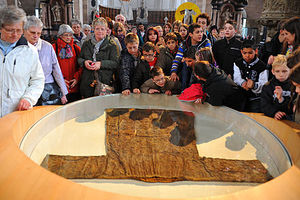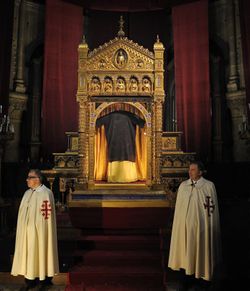Category:Holy Robe (subject)
According to Christian traditions, the Holy Robe are the garments and the coat Jesus wore at his crucifixion.
Overview
According to the Gospel of John, the soldiers who crucified Jesus divided his himatia (over-garments) "into four piece" but cast lots to determine who would keep his chiton (tunic) because it was woven in one piece, without seam (John 19:23-24; cf. LXX Psalm 21 [22]:18-19).
Western traditions
The possession of the seamless tunic of Jesus is claimed by the Cathedral of Trier [Germany] and by the parish church of Argenteuil [France].
(a) The Trier Robe
A tradition of the Latin Church holds that the seamless robe that Jesus wore at his crucifixion was rediscovered in the 4th century at Jerusalem by Helena, the mother of Emperor Constantine, and brought to Tier [Germany]], where the relic is still housed in the Cathedral.
The presence of the Robe at Trier is well-attested since the 12th century. As in the case of most medieval relics, it is very difficult to say more about its origin. An independent scientific examination of the specimen has not been conducted.
The relic is rarely displayed to the visitors, the last times in 1933, 1959, 1996, and 2012.
(b) The Argenteuil Robe
Another tradition links the seamless robe to the Benedictine monastery of Argenteuil [France], as a gift of the Emperess Irene to Charlemagne. The earliest document from the 12th century describes the relict as the garment of the child Jesus, which however was believed to have grown miraculously with him during his entire life. While both Tier and Argenteuil claim to possess the authentic seamless robe of Jesus, attempts have been made to harmonize the two traditions by suggesting that one of the two could actually be the mantle, not the tunic of Jesus.
In the aftermath of the French Revolution, the monastery of Argenteuil was destroyed and allegedly the local parish priest in order to hide the relic cut it into many pieces of which only four survived and were moved in 1865 to the present church of Argenteuil. The relic was apparently stolen in 1983 but soon recovered. The last solemn expositions of the tunic was held during Easter 1984 and 2016.
Eastern traditions
According to an Eastern Orthodox tradition, portions of Jesus’ clothing are preserved in the crypt of the Patriarchal Svetitskhoveli Cathedral in Mtskheta, Georgia where the feast day in honor of the Chiton of the Lord is celebrated on October 1.
Other portions of Jesus’ Robe are believed to be preserved by the Russian Orthodox Church: in Moscow, Saint Petersburg, Kiev, and other monasteries. The Russian Orthodox Church commemorates the Placing of the Honorable Robe of the Lord at Moscow on July 10 (July 25). At Moscow annually on that day, the robe is solemnly brought out of the chapel of the Apostles Peter and Paul at the Dormition cathedral, and it is placed on a stand for veneration by the faithful during the divine services.
Modern legends
The legend of the Holy Robe inspired in 1942 a novel by Lloyd C. Douglas, and in 1953 a movie, directed by Henry Koster, with Richard Burton, Jean Simmons, and Victor Mature.
External links
Pages in category "Holy Robe (subject)"
The following 2 pages are in this category, out of 2 total.
Media in category "Holy Robe (subject)"
The following 3 files are in this category, out of 3 total.
- 1942 * Douglas (novel).jpg 375 × 499; 35 KB
- 1953 * Koster (film).jpg 325 × 496; 85 KB
- 1954 Daves (film).jpg 285 × 395; 37 KB





